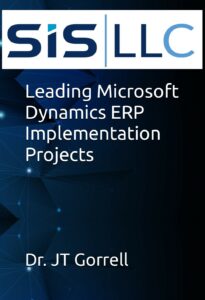Q&A Blog Categories
Supply Chain
Change Management
Business Intelligence
Project Cost Management
Managed Services
Enterprise Asset Management
ERP Implementation Projects
Construction Finance
ERP Project Managers
Construction ERP Pain Points
Women in Construction and Why it Matters – to Everyone
On-Premise, and Other Construction ERP Insights
Real Cost of Procession Union Payroll Manually
AI in construction
ERP User Adoption
Construction ERP Visibility
Changes in Construction Technology
Author, Dr. JT Gorrell | SIS Senior Director, Services
![]() Interview by: Sarah D. Morgan, SIS Senior Marketing & Brand Manager
Interview by: Sarah D. Morgan, SIS Senior Marketing & Brand Manager


This week I sit down with, Dr. JT Gorrell, SIS Director, Delivery Services, as part of his doctorate, published his thesis titled, “Leading Microsoft Dynamics ERP Implementation Projects.” The title of the book is clear in that the subject matter guides the reader through leadership and success factors of implementation projects including cultural impact. The book begins with ERP discussion overall and moves into Microsoft Dynamics specifically. Readers can click the link at the bottom of the discussion to purchase the book on Amazon.
Q: JT, tell us how you got into Microsoft Dynamics?
A: I joined Ford as a programmer and stumbled into the SAP market. I traveled around the world and did a lot of ABAP work. In 2008 when the market got ugly, no one was buying SAP, so I found an AX 2009 project in San Antonio with Infosys and led that project for 2.5 years. In 2012 I decided to make Microsoft work my focus. Microsoft teams were far more fun to work on and with where SAP was really too big when you think of teams of 750 people on one project.
Q: About, “Leading Microsoft Dynamics ERP Implementation Projects,” what makes your book different than the many others written on project management?
A: There are not any other books on Microsoft Dynamics written in this way which is more narrow and more focused into D365 ERP. This book was my Doctoral Thesis research. It’s not about Project Management, it is about leading the implementation overall. So, there are really two main roles on the project. The Project Manager goes into the leadership of the project and the sponsor really focuses on an Executive Sponsor who is responsible for the overall success of the program. It talks about what is important for you on your Microsoft ERP project, and ERP implementations in general. There are specifics on ERP and then starts to say specifically for Dynamics Projects, here are the success factors and here are the 5 or 7 things to think about as you set up your project.
Q: You talk about problems with ERP implementations. One being inadequate planning. How is inadequate planning possible after months of RFP business analysis, scoping, design, workshopping between the client and the partner?
A: That is one of the key parts of a successful implementation. The plan is very foundational. There are projects that fail that have a good plan and projects that succeed without a plan. The blind squirrel finds a nut theory. When we talk about a project plan, many times at the end of the day they are missing a key foundational piece. Either they are making up a methodology, approach, or didn’t agree. Or they have a team and maybe have a roadmap or method, but the team hasn’t bought into it, or the client team members don’t understand their business and they churn. It doesn’t matter how good the plan is if the team can’t get on board, the plan is useless. They need to ask, what is my scope and method what is the culture of the client and the partner if your client is old school you’re not coming in with Agile. The client must understand themselves – can they keep up and support the system. All of those have come together in a schedule and get you to an end.
Q: When it comes to picking a methodology, some teach ‘throw a dart and pick one just use it’. Are some methodologies better than others when they have the same design, build, test, and deploy components?
A: The client must understand their culture and the people they have on the project. If your team needs to have everything perfect – I’s and Ts crossed etc. They are not going to be comfortable with Agile. If they don’t want to write things down, then Waterfall is going to be frustrating. There is a hybrid approach – if you understand your team – your team must be able to work in that as well. I’ve been on projects on the client side where they weren’t ready to do Agile or Hybrid and I recommended we would be more successful with Waterfall. You must understand the team culture. In my research – 95% of success doesn’t come from project plan – it is the behavior of the team. You can have the best of everything but if the team is not happy or comfortable their behavior isn’t comfortable. If the method is quirky, you have a 95% chance of succeeding. You must ask, what is going to help my team more comfortable and successful within their behavior.
Leadership needs to ask, why do we need a pm? Successful projects had the right PM. These decisions start at the top – where they must think about the behavior of their team. If they shape that, they’re going to be successful.
Q: Insufficient training makes or breaks user adoption. Why isn’t more money time and focus spent here? Is this lack of spend specifically on training a perception or a reality?
A: Clients often don’t understand the conversations we have when we go through the education process, or they assume that we have this other group, and they kick that can down the road. They think maybe user adoption is not just about training, it’s about helping the end user with the new way of working tomorrow.
People don’t like change. People who run toward it are the successful ones. It’s normal to have people fight that change. It’s natural to have to avoid that conflict with change. It’s not just about training, it’s about Change Management. Sometimes, they will use the ERP implementation to reorganize their business. Those are the times when hyper care and stabilization are going to be rough, and you must plan for that then. Companies make decisions for a lot of reasons we don’t understand on the implementation side. It’s our job to help them be successful because of their decisions. And we know how to make them successful and help them through the rough stages.
Maybe it’s they spend their implementation budget on hyper care and stabilization. A function of cash flow or capital versus expense. Bottom line, we can support the decisions they make, and we can understand the impact of that decision while planning for it up front. There should never be a gotcha at the end where suddenly there is a training cost they didn’t anticipate.
Q: In your book you mention excessive customization as a high risk. Do you have an opinion on a percentage of customization that pushes it into a risk category. Should a company look at a different solution if they have a high need for customizations? Where do ISV products come into play here?
A: Usually the threshold is no more than 20% to 30% customizations – that is usually that standard. You also must consider what are the customizations. If they are label changes or adding fields, it’s not as bad as reworking a module. For example, if you don’t want to have to post a packing slip, you want to do it later, those things are small and are worth it. The whole reason companies are in business is because they are different than the other guy. You must look at the business and challenge them by asking, “Is this what makes you different, or is it that someone wants something different because the current system does it this way?” If at the end of the day that’s what they want the total cost of ownership is at risk. Every customization is at risk. Our job is to give them all the information to make a good decision.
Q: Is it true a company with a Microsoft infrastructure is most likely going to choose a Dynamics ERP? Is this seamless integration story still true?
A: I think it is. 50% of the organizations out there want to be all Microsoft and it’s around their internal IT support strategy and availability of resources on their side. But then there are the legacy companies who still must have SAP and Oracle and have the ability to integrate through Microsoft. Whatever the other CRM, ERP, or back office to Point of Sale is, Microsoft has already gone through and experienced that and now you can say the value of Dynamics is that you can easily integrate so you can make the best choice for your company. In the past CRM and Dynamics and Salesforce may not have worked together and that is not the case anymore, so those legacy companies can build the best of breed. Plus, the ISV pool is out there.
Q: How will AI come into play for the monolithic aspect of Project Management for ERP.
A: There are many great tools out there. One of my favorites is that you can build your status report and your Power Point decks by building out a framework in Word and pushing it through. It will create a Power Point for you. Those are some of the things that are right there in front of us today. As a PM, the ability for Microsoft’s office tools to generate my status report immediately with very little touch is a game changer. Office 365 Word Online lets you save a Word doc as a Power Point. You just structure your Word document and it will create your status report, agendas, bullets, titles, the whole nine yards.
Q: We talked about it above, I’d like to completely clarify. Waterfall, agile, hybrid, or iterative. How much is the methodology choice cultural and resource availability concerned?
A: 100% cultural.
Q: In your book you talk about users not realizing at the beginning of a project the full amount of requirements they have and not getting the opportunity to readdress those later. How does this happen when user requirements are the holy grail so to speak?
A: Some methodologies solve that more than others. The whole Agile purpose is to address that. Iterative expands on requirements. Even with Waterfall or a Hybrid, you need to make sure you have the right team members on the team. The team member in that conversation example really wasn’t as engaged or informed in the process as they should have been.
